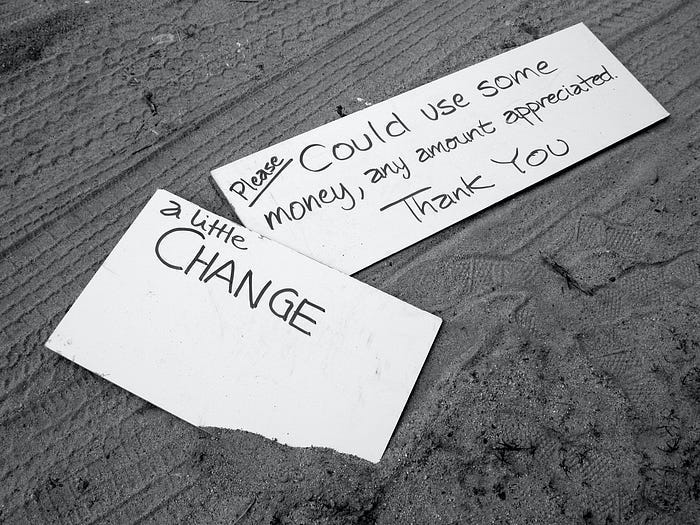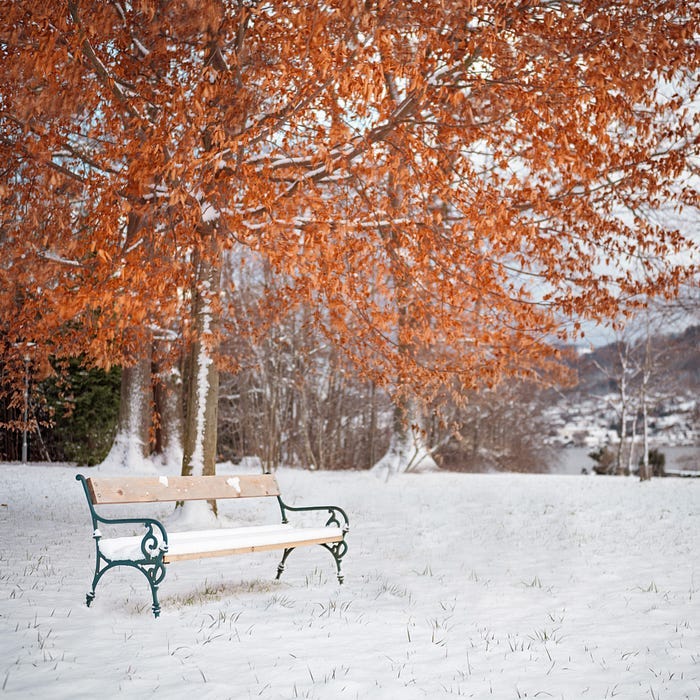What is Hostile Architecture, and Why is it Screwed Up?
As if the homeless don’t have it bad enough!

Imagine having no home for a night. No apartment, no house, no safe reliable shelter. It’s a frosty night in late fall, maybe early winter.
It’s snowing, it’s cold, and you have no money to rent a room at the motel. You have no friends nearby who have a couch or a spare room to offer, so you’re left searching for a safe place to rest your head down.
Laying down on the ground is a non-starter. You know from experience that sleeping on the snow-coated earth with no insulation will sap the warmth from your bones well before sunrise, and you’d more than likely die from exposure.
As you wander, you come upon a park bench. It’s not perfect, but it would be better than laying on the cold ground where you’d be drenched in melting snow and chilled to death.
As you come to the bench, you feel your heart drop through your stomach and shatter on the park trail. The bench is segmented with armrests that prevent you from lying down comfortably. You’ll have to crunch up into a ball to fit, and you’re going to be tied in a knot all night.
It’s been built with the sole purpose of preventing people just like you from using it as a place to sleep.
You feel the tears welling up in your eyes. You feel targeted. The only reason the bench is built like this is to prevent people like you from being comfortable. It exists to make your life just that little bit more difficult and inconvenient in the hopes that you’ll go somewhere else.
Somewhere that nobody has to look at you and remember you exist.
It isn’t as visceral as a hard boot to the ribs to make you leave, but it is just as painful.
It makes you feel ashamed.

There are a lot of things about poverty that really suck.
Healthy food is expensive, often leaving you eating cheap fast food just to stop your hunger pains. Everything you own tends to be low quality, breaks easily, and needs to be replaced often.
You may not be able to afford to buy in bulk, so you spend more to purchase daily needed goods. Your clothes are hand-me-downs, don’t fit, and tend to be torn or worn thin from age.
Poverty can be a trap. A cycle that holds you down so you can’t get your head above water.
If you have a home, you’re lucky. Even a run-down apartment is better than nothing, but the expenses can get nasty. If you’re stuck living in your car or out on the street, it’s so much worse.
A lot of that is survivable, but it’s not easy. It’s traumatizing, it tears at your mental health and leaves you stressed and tired. It wears you down to the bone.
It leaves you desperate, taking whatever work you can find even if it winds up making your situation worse. Minimum wage, entry-level jobs can be rough.They’re murder on your mental health, and on your physical health too — I know, I have arthritis. I spent most nights crying in pain at the end of my shifts at the coffee shop.
They tend to have irregular schedules, low pay, and a high turnover rate that leads to a lack of respect for workers on the part of management. Why would they care if you complain when they can replace you with the snap of their fingers?
Don’t even get me started on how poverty traps you in debt.
But to be honest, one of the worst things about living in poverty is not about the lack of money. It’s about the people around you and the way they treat you.

Some people with money treat poor people like roaches.
They view the homeless as unwelcome pests that they don’t want to hang around because they don’t want to look at them. Being poor, being homeless, leads those around you to dehumanize you and degrade you to your face.
Sometimes they’re outwardly, vocally hateful, and sometimes they just give you that look. That disdainful glance and the purposeful dismissal that makes it clear they think they’re better than you.
And because the poor are viewed as pests, some people will go to seriously petty, cruel lengths to chase them away. One of those petty means of driving people away is something called ‘hostile architecture’.
The idea of hostile architecture is very simple: Make it difficult for people to spend any length of time in a particular space.
As a really simple example, my city removes the downtown park benches from the street during the cold months. They leave them out during summer, and then they go out and collect them during fall. If you want to sit down outside, you sit down on the cold ground.
There are other common examples, like sloping windowsills on newer stone buildings. They prevent people from sitting down there or placing objects on them to keep them out of rain puddles.
Some big cities install bolts or spikes on wide flat surfaces, like the outside edges of wide stone stairways. Anywhere someone might try to sit down out of the way of foot traffic or lie down at night, the space is made physically uncomfortable.
Some places even require you to pay to use a public seating area. You pay for a set amount of time, and when that time runs out, you get a set of spikes in the backside. Not kidding.
The point of hostile architecture is to discourage people from spending time in the public area where it’s installed.
For people with money, who have homes to go back to or who can walk into any local restaurant or coffee shop and sit down with a meal or drink, this isn’t a problem. If they’re in an unfamiliar place they can even buy a room to sleep for a night.
For homeless people, people in poverty, those options might not be there.
If you don’t have money, businesses don’t like you hanging around inside taking up tables that might be used by paying customers. They call that loitering. In some places, it can even be illegal.
Having nowhere to go is a crime.

How would you feel if the furniture around you was built specifically to be uncomfortable? If the only places you could sit down or sleep had spikes, or blades, or awkward armrests that prevented you from resting there?
I imagine you would feel unwelcome and less-than.
We’re all expected to pay for comfort and shelter and security in some way or another, but have you ever thought about how awful and exploitative that truly is? I wager most of us don’t, because for us it isn’t as obvious as an in-your-face ‘fuck you’.
I doubt that the majority of people who read my essays ever worry about where they’re going to sit down outside. Like I said, most of us have homes to go back to, and we can walk into coffee shops and buy a drink if we want to hang out somewhere in public.
But for the homeless, this is just another level of dehumanization.
Installing hostile architecture does not solve the problem of poverty and homelessness, it only kicks it under the rug. It sends the message that the people responsible don’t care about the human being who is struggling, they only care about keeping them out of sight.
We do this with animals, for goodness sake. We set up bird spikes to keep pigeons from perching and shitting on walkways. And now, we’ve decided to do the same thing to keep homeless people out of eyesight for the people who ‘matter more.’
It’s like a little kid who hasn’t developed object permanence yet. If I don’t see it, it doesn’t exist.
Hostile architecture is part of a pattern in our society which treats the suffering person on the street like vermin, something unwelcome and unsightly. It treats them like a stain on the ground that needs to be rinsed away.
But these aren’t vermin. They’re human beings. They’re people who’re stuck in a system that continually proves to them that they’re less valuable than others.
In the eyes of the people who make decisions about the world they live in, they’re an afterthought. And even then, only in the form that they’d rather they just go away and be somebody else’s problem.
I can’t think of a clearer, more poignant example of a dystopian system than that.
Solidarity wins.


"Having nowhere to go is a crime".
I am with you there. A year ago my soon to be ex literally kicked me out after 25 years and put a hotel lock on the door (which is illegal) and left me in the parking lot of our apartment building. Thanx in part to my "cloud if witnesses" I never had to spend a night outside ( sometimes the system works) nor at the unsafe Rescue Mission.
I have worked with the Salvation Army and helped run both a Homeless Shelter and an elder group home. I also empathize with the person in the back pew on Sunday morning waiting for a hoped for coffee hour where they might get something to eat.
"Having nowhere to go is a crime"
You have spelt out the meaning of the little-known (for us down under) term "hostile architecture".
Although it's probably not a buzz-word in my town I have heard of the concept of designing public benches to make homeless users too uncomfortable to linger.
The homeless are mostly not mentally-ill but have lost first their job and then their home (and possibly their family in the process). These dominoes fall one after the other in an inevitable fashion. Some of them are youngsters who're running away from home or state child care.
In the first case people have no option (having already temporarily imposed on friends/family) whilst in the second "hostile emotional architecture" at home has made the person abscond.
However people become homeless police make their lives even more disagreeable than they already are by harassing them and moving then on all the time. We know that benefits are not payable without a permanent address, so no benefit.
Emergency Housing is under attack by the right/libertarian/populist government with thousands of places no longer supported. So, it's the streets and then the deprivation, stigma and threats to health.
We don't like seeing them - they offend us. But if we can possibly, a kind word or a bob in the hat can make a homeless person's day.
A much better government would have full employment by growing the public sector and giving the economy a boost whilst creating more consumers so the money goes round. But it would also have balls and heart.